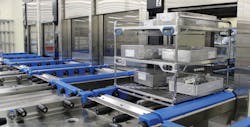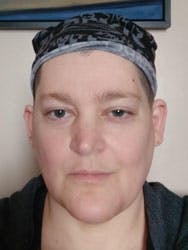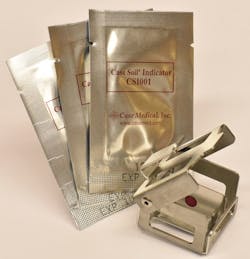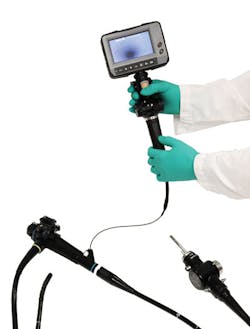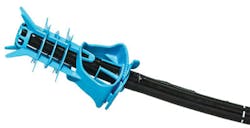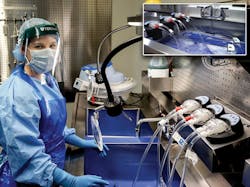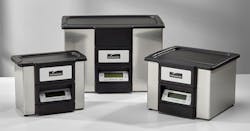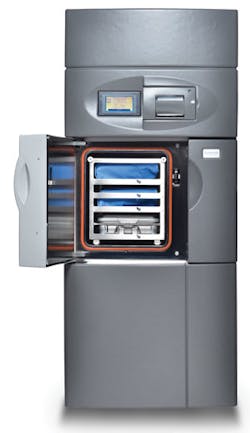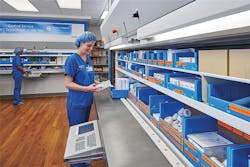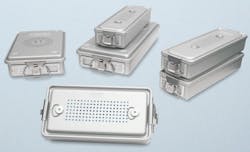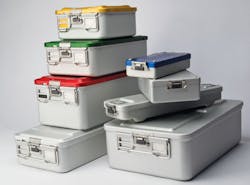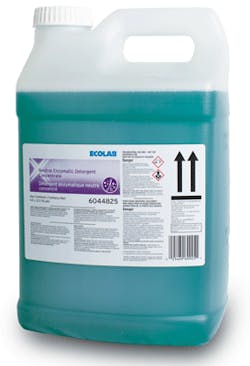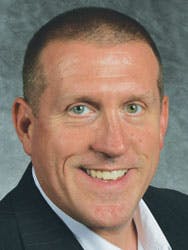2018 SPD Equipment & Technology Guide
Most sterile processing conversations continue to focus on what’s happening (or not happening) before and after device sterilization. Issues such as complying with cleaning standards and following IFUs (instructions for use), having the right tools and equipment to soak instruments and remove hidden debris, testing and monitoring, adequate time and space to work, sufficient inventory, and timely delivery of instruments are common themes. But one repeating subject in particular — respectful, inter-department communication — is probably the underlying factor that gives sterile processing departments (SPDs) the ability to ace those and other functions they perform every day.
Collaborate and cooperate
It’s no secret that surgical staff and sterile processing staff butt heads from time to time — more often for some and less frequently for others, especially among those who join forces quickly to find solutions when problems do occur.
Troy Scroggins, Product Manager, Sterile Containers, Aesculap, says the OR expects the SPD to deliver the right instruments at the right time and in the right/proper condition. Sounds reasonable but it doesn’t always turn out that way. As for where to point when problems do occur, well that depends. In fact, it’s often a combination of different factors that can lead to case-cart delays, damaged or missing instruments and other problems that can compromise a surgical case.
“Holes in sets delay cases. Missing or wrong instruments can happen because they are not organized or optimized,” said Scroggins. “Dull or broken general and specialty instruments can lead to higher repair costs and cause case delays.”
Those are just a few examples of what can go wrong and while it may be the fault of one or more people, poor product quality could also play a role. It could even be both — human error and substandard tools. Or perhaps the wrong sterile processing product was used in the first place. On the flip side, delays, damaged products and other problems could be directly related to mistakes made in the OR, inadvertent or not. Failing to keep instruments moist immediately following use during surgery is one example.
The important piece in all of this is that finger-pointing alone rarely works. Rather, the focus should be on improving the situation, with both departments making a sincere effort to investigate, jointly, all possibilities that lead to problems and find sustainable solutions. There must be “more shared team-building, particularly with surgical technologists,” said DeMeo. “They are SPD’s natural counterpart now.”
Take suggestions seriously
If suggested processes are proven to add considerable value and safety but aren’t mandated by any regulatory bodies, should SPDs adopt them anyway? Unlike some other countries, the U.S. does not require facilities to perform surveillance sampling and culturing of duodenoscopes — a process that entails following very specific, standardized protocols in order to detect bacterial contamination in the channels and distal ends of duodenoscopes. Nonetheless, some healthcare facilities are making it their policy anyway, which is wise considering the serious and sometimes deadly consequences that contaminated scopes have had on the lives of patients and providers in recent years.
A Department of Health and Human Services (HHS) collaboration released a 58-page document earlier this year to assist SPDs that wish to employ duodenoscope surveillance sampling and culturing.1 You can find more details about the guidance in this month’s IAHCSMM Viewpoint.
“Duodenoscope surveillance culturing requires specific resources, training, and expertise, and not all healthcare facilities may be able to implement this type of testing,” stated the HHS. The new document, Duodenoscope Surveillance Sampling & Culturing, an update to a 2015 interim guide, is for facilities seeking to understand and apply the protocols. The procedures are based on the latest research and developed by experts from government agencies, professional societies, universities and scope manufacturers.
As most know, just because there’s no more visible debris after washing an instrument doesn’t mean it’s clean. That goes for anything used in a surgical case, not just scopes. However, knowledge doesn’t always lead to action. The Association for the Advancement of Medical Instrumentation (AAMI) has called on SPDs to ramp up certain processes for detecting hidden soil so hopefully attitudes will change.
“AAMI now recommends daily monitoring of automated equipment, which includes automatic washers and ultrasonic cleaners,” said Marcia Frieze, CEO, Case Medical. “Until recently, automated equipment was tested on a weekly basis, not frequent enough to pick up on process or equipment failures.”
Frieze says most of the test indicators available previously have limited capabilities. One solution is the new Case Soil Indicator by Case Medical, a universal tool for monitoring cleaning effectiveness, which received a utility patent earlier this year.
“The product was developed over the past three years and introduced in 2017 as a unique wash monitoring device that more realistically represents the organic soils found on soiled surgical instruments within an instrument tray,” she said. “The stainless-steel coupon contains a consistent mixture of sterile blood components, proteins, fat and carbohydrates typically found on the surfaces of used medical devices. The coupon, with a defined area for inspection at center point, is placed within a hinged stainless-steel holder, representative of a surgical tray. Case Soil Indicators, a go/no-go monitor, have a red indicator which is visibly clear after cleaning. No guess work is involved for visual inspection. Case Medical also offers a protein detector to address the presence of non-visible soils. When a drop or two is applied, the solution turns blue to indicate the presence of residual proteins that were intended to be removed. No blue coloration means that the device is good to go.”
Earlier this year Healthmark Industries added the Video Inspection Scope with Display to their ProSys Optical Inspection product line. Marketing Manager Matt Smith says the scope features a four-way articulating tip composed of a light source and camera lens at the end of a 120cm flexible shaft. The tool can inspect instruments 2.5mm in diameter or larger. The Video Inspection Scope with Display contains a 4.5-inch LCD monitor equipped with a USB port and an SD card slot, allowing use without the need for a computer. It also allows for capturing and saving images and video for later recall and documentation. “The Video Inspection scope is the perfect tool to get a visualization of the internal channels of devices,” said Smith.
In addition, Andy Eakins, DipM, MCIM, Product Developer of Ruhof’s TipGuard, cited an ample body of research that strongly encourages the use of distal tip protection, which is essential to preventing damage, including microscopic cracks and tears that can turn instruments into lethal weapons. “A review of an outbreak of antibiotic-resistant bacteria at UCLA that resulted in two patients dying, found that the endoscopes were properly reprocessed, yet the bacteria were still passed on,” said Eakins. “What this points to is the fact that even when the reprocessing protocol is properly followed, there is a very real risk that antibiotic-resistant bacteria can be passed from patient to patient. And because they can withstand antibiotics, adding more steps to the reprocessing procedure may not be sufficient to protect patients from cross-contamination. The role of damage to an endoscope’s distal end and therefore the potential to harbor contamination has become a very real issue and one which is being solved with new sophisticated fit-for-purpose tip protectors.
“Use of these next generation endoscope tip protectors will do much in helping you stay compliant, achieve best practices and more importantly, avoid the pitfalls of potential cross-contamination though the reuse of a damaged endoscope,” continued Eakins. In addition to the reduction in tip damage, scope repairs and loan scope requirement, other potential benefits includes reducing repair/warranty costs, reduction in cancelled procedures due to non-availability of scopes and potentially less damage which could harbor contamination.”
Wise up on washing
Finding detained debris in an instrument could also be an indication that an SPD needs to think seriously about its cleaning protocol and maybe consider an equipment upgrade. Dan Gusanders, President and Founder, Pure Processing, says relying on syringes and spray guns to flush out reusable lumened devices prior to sterilization is a tedious method that doesn’t always work well. Gusanders explains what can happen:
“Departments that use syringes during the pre-cleaning process, deliver tiny amounts of cleaning solution through instrument channels filled with bioburden, at an uneven low pressure. Due to the intense manual work of repeatedly filling, connecting and plunging the syringes and the time it takes for such a laborious process, guidelines and standards are often not met or overlooked. This is dangerous for patients because the hidden bioburden inside these channeled instruments can break free during the next use and infect the subsequent patient.”
The Pure Processing FlexiPump Independent Flushing System, introduced in 2014, flushes instruments faster and more thoroughly. The FlexiPump can flush three instruments at once with consistent flow, and has programmable cycles that allow techs to tend to other tasks while avoiding the discomfort and stress of performing the manual flushing by hand. “The FlexiPump’s integrated pressure relief valves protect delicate eye instruments, robotics, and suction tips from excess pressure,” said Gusanders. “Additionally, the FlexiPump helps departments meet standards, guidelines, manufacturer IFUs and OSHA recommendations, all to help improve patient outcomes and worker safety.”
the PureSteel Healthcare Reprocessing Sink
The ergonomically designed PureSteel Healthcare Reprocessing Sink series is also designed to alleviate the chronic back pain and fatigue commonly experienced by technicians.
In addition to the differing processes performed across multi-site health systems, which makes achieving standardization a challenge, Sarah Seaton, Marketing Manager, Midmark, suggested that mistakes, shortcuts and injuries are also the result of the increasing mental stress placed on SPD workers. “There’s a common pressure to work faster at every step of the customer care process as better throughput can mean more income for the health system,” she said. “But this performance pressure can bring risks of cleaning or sterilization steps being skipped, or staff suffering a sharps injury as they try to manually process instruments.”
According to some tests, she says Midmark’s QuickClean Ultrasonic Cleaner can cut wash-time by as much as 60 percent compared to early generation ultrasonic cleaners. “QuickClean uses Frequency-Leap software to help ensure all of your instruments are fully cleaned the first time, every time, no matter where they are placed in the basket,” said Seaton. “Automatic cleaning is more effective and more consistent than manual cleaning. It not only produces cleaner instruments without the variability of manual washing, but it ultimately helps ensure a safer environment for both the staff processing instruments and the patients exposed to the instruments. With solutions for automatic cleaning, sterilization, and medical-grade casework we can support your need for a standardized process. And our technologies are engineered for simplicity to ensure compliance.”
All set to sterilize
Only after using the best tools available while following industry standards and practices — every single time — will surgical devices be ready for the sterilizer. When they are, look to new technologies for this important step.
Cindy Clark, Senior Vice President, Global Commercialization, TSO3 says the company’s STERIZONE VP4 Sterilizer can handle low-temperature sterilizable devices, including complex and sensitive multi-channeled endoscopes, like gastroscopes and colonoscopes. The STERIZONE VP4 Sterilizer is able to process three sets of robotic surgical tools simultaneously in the same load; sterilize orthopedic tools and their batteries at the same time; and it can handle mixed loads of general instruments up to 75 pounds (visit the TSO3 website for more details).
“This system offers the lowest cost per instrument sterilized compared to other low-temperature hydrogen peroxide systems (based on customer usage data),” said Clark. “It is safe for your patients and staff, and can significantly increase your throughput. Customers have reported 25 percent to 50 percent cost savings, and double the throughput in the STERIZONE VP4 Sterilizer compared to other low-temperature sterilizers. With the increased throughput, your facility could reduce the number of sterilizers in your department and still process the same or greater volume of devices,” Clark asserted, noting also that the machine could help facilities reduce instrument inventory and/or
expand SPD output.
Calm and organized
It’s impossible to run a smooth SPD when staff spends too much time and energy searching for items they should already have on hand, addressing damage that could have been avoided, and straining and stressing in an effort to keep cases moving. Such a scenario sets off a domino effect that doesn’t stop at the SPD exit either. Inefficiencies in the SPD impact surgical staff, patients, and a facility’s bottom line.
“It’s a common occurrence to assemble a case cart, only to discover a ripped sterile wrap after it reaches the OR — or worse, a missing tray or item necessary for the procedure,” said Amy Flynn, OR/CS Market Manager, Hänel Storage Systems. “That sets off a mad scramble to replace that tray of instruments or locate the missing trays and/or items.”
Also, along with surgical instrument innovation is the need for more space in the surgical suite to accommodate new equipment which often necessitates reconstruction and/or expansion. It’s not unusual, says Flynn, for facilities to sacrifice other departments for that to happen. “In order to provide for an OR expansion, space is typically cut from storeroom areas, whether it’s sterile storage, materials management or central supply. As a result, those departments must store 20 percent to 40 percent more inventory within a much smaller footprint.”
It doesn’t end there. The repercussions can be quite serious and far-reaching. “Storerooms, warehouses, sterile processing and even maintenance departments suffer significant man-hours lost to workplace injuries such as back strains, falls, trip hazards and repetitive hand and arm injuries,” added Flynn. “Inspectors from Joint Commission, CMS and other agencies often find many outdated or expired items, as well as surgical trays and soft goods stacked closer than 18 inches from the ceiling.”
Hänel’s Rotomat Vertical Carousel, developed in 1957, certainly isn’t new but its application in the SPD didn’t happen until decades later and has since proved to be an excellent solution for space-strapped facilities. “The Sterile Processing Departments of several dozen U.S. hospitals have taken advantage of automated vertical carousels to manage sterile instruments, implants, soft goods and a variety of other stored inventory in the SPD and the OR,” said Flynn. “Early adopters in hospitals have realized the significant cost reduction opportunities available to them whether it’s saving floor space, closely tracking stored inventory, reducing the time to pick a case cart, eliminating the hunt-and-peck search for trays, or providing an ergonomically correct work environment for their staff.”
Today’s container is a no-brainer
Launched in 2014, ONE TRAY by Innovative Sterilization Technologies, LLC (IST) offers a unique container system that the company says reduces overall reprocessing time significantly — something every SPD certainly wants. “The increased demand for the timely turnover of instrumentation while meeting regulatory requirements creates the need for ONE TRAY,” asserted Mike Faulkner, President of Sales, IST. “ONE TRAY addresses these challenges by giving sterile processing departments the ability to take their current post-decontamination sterilization processes from hours to minutes. The ONE TRAY patented technology accomplishes this by eliminating the need for both dry and cool times. The time savings this creates increases efficiencies not only for SPD, but also for the OR. These efficiencies help to create a more cohesive working relationship between the departments, and have a positive impact on bottom-line savings. ONE TRAY also gives facilities the ability to eliminate the need for immediate use steam sterilization (IUSS) and provide one standard of care for every patient.
Amy Wiedre, Marketing Manager, Service Marketing, KARL STORZ Endoscopy-America, Inc., says for a variety of reasons, Healthcare facilities are moving away from blue wrap in favor of trays and containers that don’t require it. “Sterile Processing Departments are challenged by the need to control escalating costs, unwanted waste and compliance concerns associated with the use of outdated, costly sterilization trays,” Wiedre said. “SPD and OR staff members often spend considerable time and effort checking for holes and tears in blue wrapped trays both before and after the sterilization cycle. If such a tear is discovered the tray must be rewrapped and reprocessed. Following use, blue wrap must be discarded.
“KARL STORZ no-wrap sterilization containers require the use of disposable components for each cycle, including filters, process indicator, and tamper-evident seal; however, the efficiency gain and lower costs associated with these disposable items are minimal in comparison to the disposable costs associated with blue wrap sterilization,” Wiedre continued.
One health system conducted a three-year study by switching to 25 no-wrap containers for its KARL STORZ camera heads and discovered a cost-avoidance of $5.86 for each container use with a projected total cost avoidance of $29,000, according to Wiedre. “The results reflect the impact of an investment in just 25 camera head containers; imagine how much more cost-savings can be achieved if they were to convert all of their blue-wrap trays to no-wrap sterilization containers,” she said.
Scroggins (Aesculap) agrees. “Rigid sterile containers can help hospitals reduce case delays related to holes in wrap, decrease processing time, ease tension between the OR and SPD, and reduce overall processing costs.
“In addition, many hospitals use multiple brands of containers. Standardizing on one brand for all sterilization modalities can help provide a reduction in product and process variability. This reduction may lead to an increase in efficiencies of the OR-SPD reprocessing cycle, a simplification of process documentation and IFUs and a possible reduction in OR-SPD stress. Most importantly, standardization may provide better patient outcomes.”
The Aesculap SterilContainer System consists of 24 different sizes, may be used to sterilize pre-configured Orthopedic/Spine/Specialty sets, and has been validated and FDA Cleared for Low Temperature (STERRAD, STERIS), PreVac Terminal, IUSS and EtO sterilization modalities. Instrument Organization System (IOS) that can extend the service life of instruments and the new PrimeLine Pro lid option has an integrated reusable filter, is FDA-cleared for PreVac Steam and IUSS sterilization modalities, and can be be inspected in place in the SPD and OR.
Gimme more guidance
SPD staff is saddled with a lot of responsibilities and working in a high-pressure job without the proper support and guidance only adds more stress to an already difficult job. “Often SPD’s lack resources to support quality initiatives, absorb dynamic workloads, train staff and maintain competency in an environment where turnover is generally high,” said said Linda Homan, BSN, CIC Senior Manager, Clinical and Professional Services. “At Ecolab, we believe SPD outcomes can only be achieved through a programmatic approach focusing on more than just products, but also the entire process that makes or breaks quality outcomes. Through Ecolab’s Central Sterile Program, we aim to create a partnership with SPDs to enhance quality by focusing on factors that impact outcomes.
“We offer our customers insights on how to optimize their wash processes, provide premium detergents and tailor cycle parameters to achieve desired outcomes,” Homan continued. For example, “Ecolab’s Neutral Enzymatic Detergent Concentrate, when applied optimally in automated washing applications, has allowed facilities across the country to realize cost savings by reducing water consumption, energy use, and waste. In one of our case studies, we were able to uncover more than $13,000 savings and four additional wash loads in a 24-hour working period for a 200-bed medical center — a significant savings in total cost of operation and improvement on throughput.”
DeMeo says facilities must also invest in its own dedicated educator for sterile processing or, “if the hospital is under 250 beds, then a combined surgical services educator dedicated to halving their time and responsibility to sterile processing,” would greatly improve processes.
AAMI also introduced a brand new online tool to help SPDs prepare for accreditation surveys.3 The online assessment, 158 questions covering 13 topics, can be used to evaluate and monitor SPD alignment with ANSI/AAMI ST79:2017, Comprehensive guide to steam sterilization and sterility assurance in health care facilities. The tool is based on a technical information report, AAMI TIR79:2018, which contains a checklist of the main recommendations from the standard. More information about the tool can be found in this month’s Newswire article, New online tool helps SPDs prepare for Accreditation Surveys.
Masters of maintenance
While many hospitals have succeeded in drastically reducing or even eliminating the use of IUSS, plenty of facilities have a long way to go. Justin Poulin, BSN, RN, CCSVP, CMRP, Clinical Operations Executive, Northfield Medical, offers some practical suggestions for not only SPDs but ORs as well, which is where IUSS takes place. Improved communication between the two departments is a given, as noted earlier, but Poulin says inadequate inventory, poor maintenance, and delayed returns on repairs are common problems that can be addressed successfully by employing some sensible strategies.
“Operating room delays due to malfunctioning equipment or dull instruments have a direct impact on patient outcomes and can largely be avoided,” said Poulin. “Partnering with your repair company to establish a regular service interval for instrument sets and regular inspections for equipment can help to identify minor damages before they cause major problems for the patient and your budget.
“Capitated agreements are another effective way to manage costs and promote optimal turnaround times for repair,” he continued. “In a capitated agreement, equipment is sent in pre-approved and this approach eliminates the delays that can result from the lack of approval and/or purchase orders to process the repair. When equipment is out for repair, the remaining inventory has to pick up the slack which increases the risk for IUSS. Avoidable delays can result in a vicious cycle with coinciding increases in IUSS and instrument repair.”
Research strongly supports regular instrument maintenance as well, particularly when it comes to avoiding scope malfunctions. “Endoscope repairs are typically sent out for repair only when they fail leak tests or have functional failures that negatively impact their use during procedures,” said Eakins (Ruhof). “However, scientific studies and reports from outbreak investigators suggest that endoscopes may require more frequent maintenance to ensure they can be safely used.”3
Poulin suggests facilities could also consider purchasing certified, pre-owned inventory when upgrading or expanding its equipment supply. “One Northfield customer recently saved approximately $25,000 over the cost of new when upgrading three power drills,” he said. “Purchasing certified pre-owned rigid scopes and adding to your inventory will reduce the occurrence of IUSS and the need for costly repair exchange programs that come at a premium for convenience, “ he added.
Going forward, it’s pretty clear that facility executives across the board have much to think and act upon if they want to present themselves to patients and payers as safe, cutting-edge surgical providers.
“It will take the executive leadership team, quality, infection control, surgical services and others to fully begin to recognize that SPD is the counterpart for surgical services,” DeMeo concluded. “Thus, recognizing it as an equal in helping to secure a quality-focused and fiscally sound surgical team for its patients and community in which it services verses an expense department.”
References
- Duodenoscope Surveillance Sampling and Culturing Protocols; developed by the FDA/CDC/ASM Working Group on Duodenoscope Culturing.
- http://www.aami.org/productspublications/articledetail.aspx?ItemNumber=5770
- Cori L. Ofstead, MSPH; Mariah R. Quick, MPH; John E. Eiland, MS, RN; Steven J. Adams, RN, CRCST. A glimpse at the true cost of reprocessing endoscopes: results of a pilot project. IAHCSMM Communiqué May 2017.
About the Author

Valerie J. Dimond
Managing Editor
Valerie J. Dimond was previously Managing Editor of Healthcare Purchasing News.
